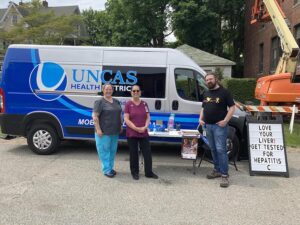We are just a few short weeks away from sending our children back to school for the 2023-24 academic year. While shopping for pencils, notebooks, and school clothes may be top of mind, Uncas Health District also reminds parents to ensure their children are up-to-date with their routine vaccinations.

To help parents take care of this important preventative health need, Uncas Health District will be out in the community with our Mobile Health Team offering preventative health care such as blood pressure screening, COVID-19 and Flu vaccines, Hepatitis C / HIV testing, syringe services, wound care info, and information about other health services offered by the Uncas Health District.
Upcoming Mobile Health Team Appearances
| Friday, August 4 | 10 AM – 11 AM | MOBILE FOOD PANTRY at Preston Senior Center |
| Wednesday, August 9 | 4 PM – 5 PM | MOBILE FOOD PANTRY at Three Rivers Community College, Norwich |
| Thursday, August 10 | 1 PM – 3 PM | UCFS Health Fair, Norwich |
| Tuesday, August 15 | 11 AM – 1 PM | Franklin Senior Center |
| Wednesday, August 16 | 10:30 AM – 1 PM | St. Vincent DePaul Place, Norwich |
| Thursday, August 17 | 4 PM – 5:30 PM | MOBILE FOOD PANTRY at Griswold High School |
| Wednesday, August 23 | 1 PM – 2 PM | MOBILE FOOD PANTRY at Dodd Stadium, Norwich |
| Tuesday, August 29 | 11:30 AM – 3 PM | Three Rivers Community College Health Fair, Norwich |
| Wednesday, August 30 | 11 AM – 3 PM | Three Rivers Community College Health Fair, Norwich |
